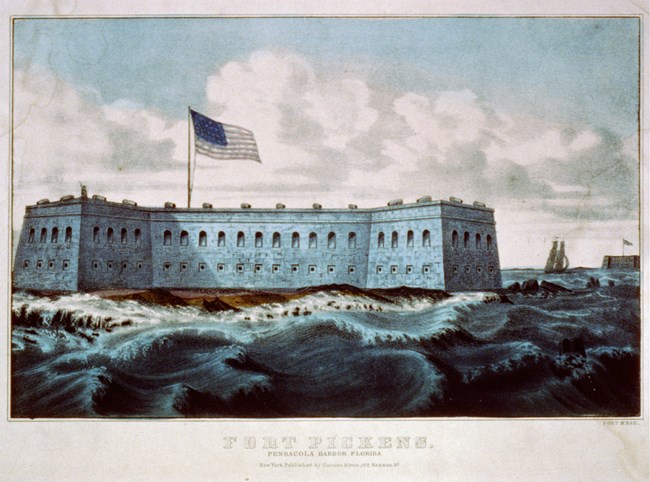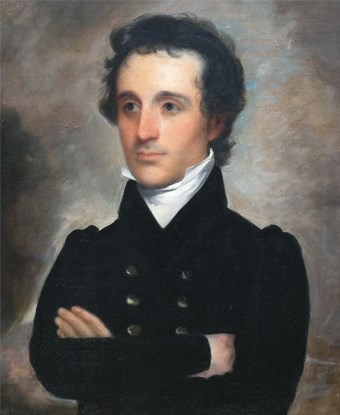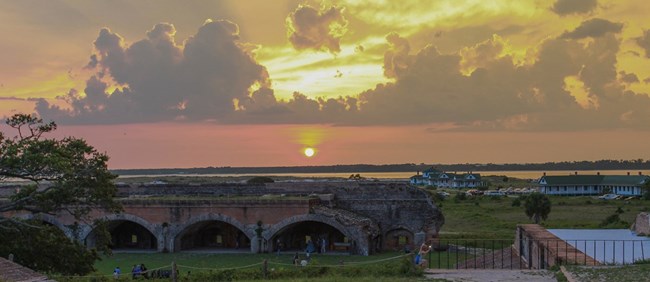Part of a series of articles titled Conversations about Legacies of Slavery .
Article
(H)our History Lesson: Betrayal at Fort Pickens

This lesson was adapted by Talia Brenner and Katie McCarthy from the Teaching With Historic Places lesson plan, "Fort Pickens and the Outbreak of the Civil War". If you're interested in more information and activities on this topic, explore the full Teaching with Historic Places lesson plan.
Grade Level Adapted For:
This lesson is intended for middle school learners, but can easily be adapted for use by learners of all ages.
Lesson Objectives:
Learners will be able to...
-
Describe how white Americans benefited from the institution of slavery and why they were willing to fight to uphold it.
-
Analyze a letter from William Henry Chase that describes the “benefits” of southern secession.
-
Determine the central ideas or information of a primary or secondary source.
-
Identify aspects of a text that reveal an author’s point of view or purpose.
Inquiry Question:
How do the people and places you interact with affect your personality and values?

Reading:
Background:
In January 1861, William H. Chase approached Fort Pickens, a fort he helped build, and demanded its surrender. As an officer in a Confederate-aligned militia, Chase was trying to seize the fort from the U.S. Army, in which he had served only years before. To understand how Chase could have such a dramatic reversal of loyalty, we have to first look at his career in the decades before the Civil War.
Reading:
Surprisingly, William Henry Chase did not grow up not in the American South. He was born and raised in what is now Maine (then part of Massachusetts). After graduating from the Military Academy at West Point, Chase began working with the U.S. Army Corps of Engineers. He moved to the South in 1819.1 Chase married Anne Mathews, a member of an extremely wealthy Southern family. As a result of the marriage, Chase became the owner of many large plantations.2 The largest was 6,000 acres (over nine square miles).3 These plantations functioned through the labor of enslaved people.
In 1829, Chase began serving as the Superintending Engineer in Pensacola Harbor, Florida.4 His job was to oversee the building of harbor defenses. Fort Pickens was the first construction in the Harbor that Chase supervised.
Using U.S. Army money, Chase “rented” enslaved people to do the actual work of the construction. Enslaved people worked as laborers and in skilled positions such as mechanics.5
In this renting system, Chase paid plantation owners in exchange for work from the people they enslaved.6 Enslaved people did not receive any of the money that was exchanged. “Renting” enslaved people was common in both the U.S. Army and Navy and made up an enormous industry in Pensacola in the 1830s.7
In the United States at this time, increasing numbers of white people began to support abolishing slavery.8 Abolitionists criticized the U.S. military’s practice of renting out enslaved people. To avoid criticism, Chase contracted with plantation owners using unofficial “gentleman’s agreements.”9 These were verbal agreements, so there was no written record. The U.S. Army Corps of Engineers continued to rent out enslaved people through “gentleman’s agreements” until the Emancipation Proclamation in 1863.10
Chase also used his role in the Army to profit personally. Since he was responsible for the construction of forts in Pensacola Harbor, he could choose where to buy raw materials. Chase established his own brick factories, using enslaved laborers. He then used Army money to buy bricks from himself.11 Chase was highly concerned with making a profit. He also ran banking, real estate, and railroad businesses, in addition to the plantations he inherited.12 Slavery made these ventures very profitable, since Chase did not have to pay enslaved people.
Following President Abraham Lincoln’s election in November 1860, Southern slaveholding states began seceding from the United States. Wealthy white Southerners believed that Lincoln would abolish the system of slavery on which they relied. When Florida seceded in January 1861, William Henry Chase was appointed as an officer in the secessionist Florida militia. These secessionist state militias later became the Confederate Army.
When talking about the Civil War many people refer to the “Union” or the “North”, so it is easy to forget that the Yankees were actually the United States Army. At the beginning of the Civil War, the U.S. Army maintained government sites throughout the United States. Some of the earliest battles of the Civil War were attempts to defend federal properties from Confederate aggression. One such property was Fort Pickens. Chase, leading the secessionist militia in Pensacola, sent multiple communications to Fort Pickens. He demanded that the U.S. troops inside surrender. Lieutenant Adam Slemmer, the commanding officer at Fort Pickens, refused these demands. On January 15, 1861, Chase went to the fort and made his demands in person.

Chase now stood on the other side of a fort he had dedicated years to building. This moment was so dramatic that Jeremiah Gilman, a U.S. lieutenant who witnessed the encounter, later wrote out his memory of it in the form of a play script.
When looked at from one angle, this scene shows a shocking betrayal. Chase had betrayed his former commitments: to his New England roots, to the U.S. Army, and to the country as a whole. However, from another angle, his actions are not too surprising. Despite his origins in Maine, Chase had made himself into a Southerner. Throughout his career in the Army, Chase had been committed to using the labor of enslaved people.
Lt. Slemmer again refused to surrender the fort. For the next two months, Chase maintained a threatening presence of 1,700 troops facing Fort Pickens.13 Later in the war, under different Confederate officers, U.S. and Confederate troops fought for control of Fort Pickens, but the U.S. never did surrender it.
Discussion Questions
-
How did Chase “make himself into a Southerner”?
-
What were “gentleman’s agreements”? How did Chase use them to avoid criticism from abolitionists?
-
How did Chase use his military position to make a profit for himself?
-
Do you think that Chase’s decision to join the Florida militia was surprising? Why or why not?
Footnotes
1 Thomas Hulse, “Military Slave Rentals, the Construction of Army Fortifications, and the Navy Yard in Pensacola, Florida, 1824-1863,” The Florida Historical Quarterly 88, no. 4 (Spring 2010): 534.
2 David L. Walby, William Henry Chase: Uniquely American (Denver: Outskirts Press, 2014), 91.
3 Walby, William Henry Chase, 93.
4 Hulse, “Military Slave Rentals,” 515.
5 Hulse, “Military Slave Rentals,” 517.
6 Hulse, “Military Slave Rentals,” 504.
7 Hulse, “Military Slave Rentals,” 527.
8 Hulse, “Military Slave Rentals,” 517.
9 Hulse, “Military Slave Rentals,” 517.
10 Hulse, “Military Slave Rentals,” 526.
11 Hulse, “Military Slave Rentals,” 519.
12 Hulse, “Military Slave Rentals,” 521.
13 Walby, William Henry Chase, 96.
Activity:
Analyzing a Document
Have participants read the following document and answer the document analysis questions. This document is challenging, so participants might benefit from reading it multiple times and/or reading it aloud. After participants have completed the document analysis questions, discuss their responses to Question 8: What does the author give as his main reason that slaveholding states should secede from the United States? Guide participants toward the response that Chase supported secession because he thought it would economically benefit himself and other wealthy white Southerners. Discuss how Chase’s position as a person who profited from slavery might lead him to make this argument.
Document
The following passage is excerpted from a letter that William Henry Chase wrote to the editor of the New York Express in October 1860. In this letter, Chase describes the “benefits” that the southern United States would have in seceding from the United States.
The benefits to be derived to the commercial nations, at home and abroad, would be: First, the products of the great West as well as of the South, whose chief interests lie in agriculture, would be transported to the home and foreign markets at cheaper rates than many of them now are, because the lines of railways to the Southern ports would transport freight every day in the year unimpeded by the snow of Winter; and, second, the foreign ships being placed under free trade principles would so powerfully compete with the Northern ships, as to reduce freights from its Southern ports, to the lowest living rates…
…The men of the West would not only instantly pause in any hostile course towards [the South], but they would demand that their great section should be united politically, as they would be commercially, to the new confederacy. In this movement they would be joined by such of the Slave States as had kept aloof [uninterested] from the first movement of secession. And thus that great movement would have led directly, and in a brief time, to a more perfect union among twenty-four States—leaving the shipping State of Maine and the commercial and manufacturing States of Massachusetts, Vermont, New Hampshire, Connecticut, Rhode Island, New Jersey and Pennsylvania to work out their salvation in their own way…
Document Analysis Questions
-
Who wrote this document? Based on the information in the reading, how did this person make money?
-
When was this document published? Based on the information in the reading, what was happening in the United States at this moment?
-
In the first paragraph, what changes does the author predict would happen to the agricultural products of the South and West? Is this change positive or negative?
-
In the second paragraph, what action does the author predict that the West will take? Why would the West take this action?
-
What action does the author predict that the “the Slave States as had kept aloof” will take?
-
Find where the author mentions “a more perfect union among twenty-four States.” Which two regions would be included in this union?
-
What does the author predict would happen to Northern states? Does the author describe that situation as being positive or negative for the North?
-
What does the author give as his main reason that slaveholding states should secede from the United States?
Wrap-up:
-
What motivated William Henry Chase? What do his actions tell us about what he valued?
-
What does this lesson make you wonder about or make you want to explore? What is missing in this account?
-
Why might this story matter to you or to your community?
Additional Resources:
National Park Service Civil War Website
Visit the official National Park Service Civil War Web Site. This website offers the current generation of Americans an opportunity to know, discuss, and commemorate this country's greatest national crisis, while at the same time exploring its enduring relevance in the present. Also included are links to Civil War Parks, NPS education programs, and much more.
The Southern Homefront
The University of North Carolina has compiled a database of pictures, letters, and documents that describe the domestic life in the South during the Civil War. The Southern Homefront gives a comprehensive perspective about the lifestyles and attitudes common to families across the South.
Last updated: April 12, 2023
